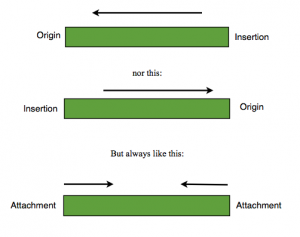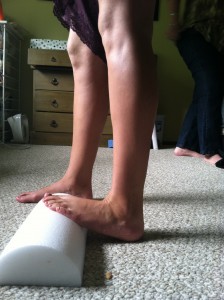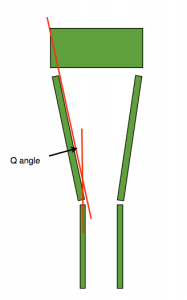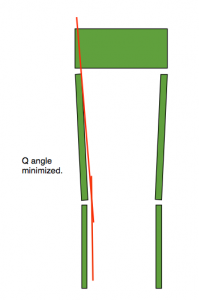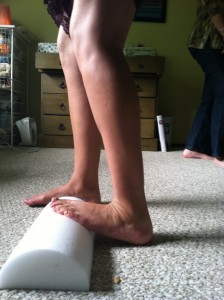Anatomical Science is really a misnomer as the Western classification system of tissues is fairly rudimentary, filled with cultural bias and just plain incorrect sometimes. To me, the worst is the origin-insertion model of muscle that has been taught since the beginning as it implies that there is an anatomical difference between the two attachment points or a hierarchy of one over the other. Also, the fact that muscular movements are taught insertion to origin, means that the student forgets that muscle does not contract in a particular direction but always toward the center of the muscle; and that the net motion is based on what all the other muscles are doing at that exact moment in time. Muscle contraction does not happen like this:
if you teach anatomy, please stop perpetuating the myth of origin and insertion and start calling them attachment points, cuz that's what they are.
Butt crack is not the most correct anatomical term for the line that separates your right and left cheek. The cleft that runs from your lower sacrum to the perineum is technically called the intergluteal cleft.
Calf Muscles are a group of three muscles: the gastrocnemius (see G), the soleus (see S), and the plantaris (see H).
Did you know that the interpubic ligament in pregnant, Free-Tailed bats will stretch 15 times its normal length in order to give birth? That's how much bigger the full-term wee bat fetus is compared to the momma bat-pelvis. So, I'm wondering why humans go on and on about our huge-headed (read: giant brained) babies when our interpubic ligament stretches only 5-6 times it's original length? Put yourself in some bat shoes, ladies. Ouch.
Electromyography (EMG) is often used in kegel research, to determine if the pelvic floor is getting stronger. The accuracy of using electromyography (EMG) on the pelvic floor is not great, however. Muscle crosstalk (any other muscle tensing in the measured area i.e., gluteals, adductors, and lower abdominals) has been shown to contaminate data. Meaning research articles that have used EMG data to show that kegels have improved the strength of the pelvic floor aren’t very accurate as it is highly likely that other muscles contributed to the quantity of the electrical signal.
Fibula. The smaller of the two lower leg bones. The fibula doesn't carry very much of your body weight. That job is given mostly to the tibia -- the bone it connects to. The fibula is still incredibly important, though, because it provides a place for many muscles to attach -- muscles that correctly steer the foot. Also, the lower leg has (or should have) the ability to rotate, unless the muscles in the lower leg have stiffened, leaving the lower leg turned out (a common source of "duck foot"). You can try this exercise to help mobilize those lower-leg twisting muscles:
Gastrocnemius is the name of the larger, round calf muscle featured prominently in movie Triplets of Bellville (which you totally have to see). It connects to the heel bone and above the knee joint, so if you want to stretch it, you can’t have any bend in your knee. At all. This is the best stretch for the gastrocnemius:
Ha ha ha ha. Made you look. Really, you’re pretty gullible. See P.
Intergluteal clefts (see butt cracks), once a remote, nocturnal creature with rare occupational-based sightings, are now often spotted on many an Applebee’s bar stool or at college campuses across the nation. It is both fascinating and frightening.
Just kidding. It’s only frightening.
Kidding again. It’s fascinating. If you’re a 15-year old boy.
"LOL" is the lazy man’s way to type internet laughing. I prefer HA HA HA HA HA HA HA HA HA HA because it burns more calories.
Metabolism, while temporarily affected by an exercise bout, is by definition made up of the metabolic activity of your muscle mass at rest. The single greatest factor that affects your muscle metabolism while at rest is its length. So, the tighter your muscles, the lower your metabolism.
Not kidding about the muscles and length and metabolism. So please stop asking me what exercises you should be doing to lose weight. Excessive body fat and/or lack of correct lean/fat mass ratio (so this goes for those that are thin as well) is essentially the same thing -- a lack of adequate muscle mass. If you want to have the correct amount of muscle mass for your skeletal mass, and to have that muscle stabilize all of your bones and joints and not be covered in a lot of body fat, you need to work on restoring the electrical channels of the muscle system (which is what alignment is, really), and then walk around a lot. I said a lot. The occasional tree climb is good too.
Occlupanid is one of my favorite words. It has nothing to do with the body or biomechanics, but it is still a very cool word. Occlu=to close. Pan=Bread. Id=A small plastic object. Occlupanid=A small plastic object used to close up the bread bag.
Plantaris. A teeny tiny muscle in the lower leg with a reallllly long tendon. This muscle typically goes unmentioned in anatomy courses because it is considered by the allopathic community to be a vestigial muscle and no longer necessary. Which is why the plantaris’ tendon is often cut out and used to make a tendon repair someplace else. Kind of like removing some boards from the foundation of your house to repair the roof. The interesting thing about the plantaris is that it has an insane amount of sensory organs -- a lot more than any other muscle in the lower leg and a lot more than in other muscles elsewhere. But, go ahead, cut it out. It’s probably not that important.
Q angle is this measurement here:
Women tend to have greater Q angles then men because they tend to have wider pelves. And, the greater one's Q-Angle, the greater the risk for knee injury. But, here’s the thing -- your Q-Angle isn't a genetic thing, but an angle created by postural habit, i.e. how close or far you put your feet while standing. Women have a (cultural-based) tendency to stand with their feet together. Very lady-like.
So, you can have some surgeries on your knee because of a high Q angle, or you can just stand with your ankles directly below each side of your pelvis:
and rotate your thighs to correctly align your femurs (click), get the correct tension on your patella, and BAM! Q angle minimized. But, you can choose surgery if you want.
Rounded protrusions to the right and left of the intergluteal cleft are the ironically named gluteus maximus muscle. These tissues, once prolific on the roaming plains of this great planet and statues throughout Rome, are rarely maximus at all in any modern human beyond the age of three, and should be called gluteus flattimus.
Soleus is the calf muscle that runs from the heel to the top of the lower leg. It does not pass over the knee joint, so it’s OK to have a bend in your knee when you stretch this muscle. In order to get it to stretch (along with the Achille’s tendon), you’ll need to decrease the angle at the ankle joint, like this:
Titin is the largest amino acid (protein) in muscle tissue. It’s very strange, then, that titin isn’t even mentioned in anatomy courses around the world. Titin is not only the largest human protein, it also has the greatest impact on the physical state of your the muscle and is the longest word in the English language. Titin is just a nickname. It’s real name is titansupercalifragilisticexpialadocious. Just kidding. Its real name is even longer than that. Titin not only plays a roll in how muscle contracts, but (probably more importantly) sets the resting length and operating range of your muscles. To know titin is to know *the answer* to all things, especially the hamstrings.
Um, Sorry. I decided to take a walk instead of come up with something for "U." It was the right decision.
Vince is my dad's name. And is also my baby's middle name. And, that's all I got. Hi Grandpa! From Finn.
“W” Does not occur in the Greek or Latin language, which is why there is no body parts with ancient “W” names. There is, of course, the names waist and wrist now. Oh, and also wisdom teeth, but I never got them so I’m leaving “W” blank.
The Xiphoid process, which is the lowest bony part of the sternum, is the only body part that starts with the letter "X." Xiph(o)- is Greek for sword, the xiphoid process being a sort of sword-like bony protrusion.
Your head is positioned how, as you're reading this?
Zygomaticus Major is hopefully contracting on your face right now. This muscle is the one responsible for your smile. Zygo- in Greek means “that which joins or binds us together.” Which I think is fitting. Zygo on: 🙂 Zygo off: 🙁
